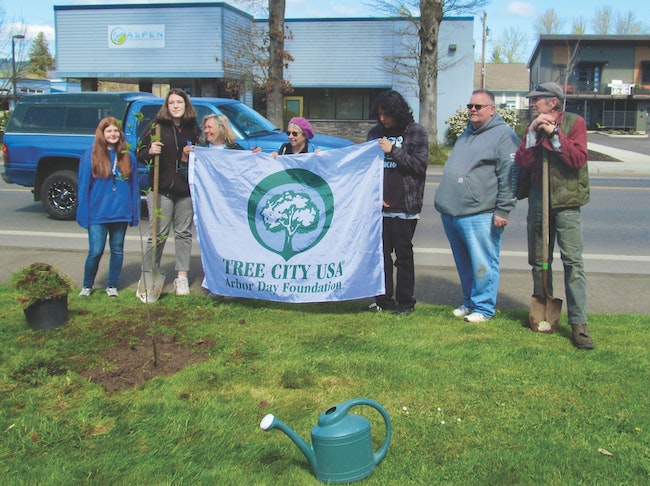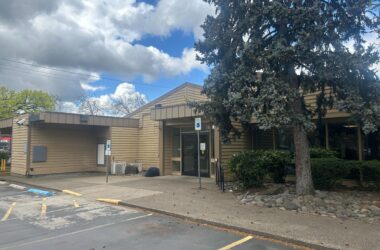 DANA MERRYDAY/CHRONICLE PHOTO – Residents plant an Arbor Day tree in Coiner Park this past weekend. From right: Matt Hall, Al Kennedy High School (AKHS) teacher/crew leader; Faye Stewart, Public Works director; an AKHS student; Susan Johnson, Urban Forestry Committee (UFC) member; and Debra Bartlett, UFC/event organizer, and two AKHS students.
DANA MERRYDAY/CHRONICLE PHOTO – Residents plant an Arbor Day tree in Coiner Park this past weekend. From right: Matt Hall, Al Kennedy High School (AKHS) teacher/crew leader; Faye Stewart, Public Works director; an AKHS student; Susan Johnson, Urban Forestry Committee (UFC) member; and Debra Bartlett, UFC/event organizer, and two AKHS students.
As summers get hotter and hotter in Oregon each year, one tool local governments use to combat the heat is urban forests. Cottage Grove and Creswell arm their residents with trees to help in the fight against the heat with tree giveaways in the spring.
“In February of 2020, we held our first annual tree giveaway and we gave away about 400 trees to residents within the community in effort to start encouraging infill trees,” said Eric Mongan, city planner for Cottage Grove. The Covid pandemic prevented the giveaway in 2021, so the event last weekend marked the changing of the seasons in more ways than one.
Kristin Ramstad, an arborist and the manager of the Urban and Community Forestry Assistance Program in the Oregon Department of Forestry, said that shading from trees helps reduce the urban heat island effect, which causes artificially higher temperatures in urban areas because pavement and buildings absorb and retain heat.
Trees can also help filter smoky air and soak up water to mitigate stormwater runoff and can “actually prolong the life of asphalt underneath them when the asphalt is shaded and not baking all the time in the sun,” said Ramstad.
As part of Gov. Kate Brown’s Carbon Policy Executive Order, the ODF created a forestry plan last session for the Oregon legislature to consider, called Policy Option Package 160 (POP 160). Along with other non-forestry strategies, POP 160 would have provided money to underserved communities to increase urban canopy cover.
However, POP 160 was not funded last session, and similar legislation has not yet taken shape, according to Ramstad.
 2019 CHRONICLE FILE PHOTOCities in the U.S. particularly devoted to maintaining a healthy urban forest can be recognized as a “Tree City” by the Arbor Day Foundation, a national advocacy group dedicated to planting trees. To be recognized as a Tree City, municipalities must meet four criteria: maintain a tree board or department, have a community tree ordinance, spend at least two dollars per capita on urban forestry, and celebrate Arbor Day. Rhodes said he takes pride in Creswell, celebrating Arbor Day in 2019, being a tree city. “We just love having the clean air, the clean oxygen and it just brings smiles to people’s faces.”
2019 CHRONICLE FILE PHOTOCities in the U.S. particularly devoted to maintaining a healthy urban forest can be recognized as a “Tree City” by the Arbor Day Foundation, a national advocacy group dedicated to planting trees. To be recognized as a Tree City, municipalities must meet four criteria: maintain a tree board or department, have a community tree ordinance, spend at least two dollars per capita on urban forestry, and celebrate Arbor Day. Rhodes said he takes pride in Creswell, celebrating Arbor Day in 2019, being a tree city. “We just love having the clean air, the clean oxygen and it just brings smiles to people’s faces.”
Springfield Operations Division manager Ben Gibson said Springfield is trying to increase its canopy cover, but it can be difficult to find additional funding. “My operations group purchased 47 new trees this year, and Friends of Trees is on track to work with us to continue growing our urban forest,” Gibson said.
Reilly Newman, the projects manager for the Coast Fork Willamette Watershed and the chair for both the Cottage Grove and Creswell tree advisory boards, has been working for more than six years to replace non-native plants with native trees along riparian areas to improve the water quality for water facilities, including the Row River and Coast Fork that flow through Cottage Grove.
Newman said that keeping water quality high in the Row River and Coast Fork is important not only for Cottage Grove, but for other cities downstream. “Any other city along the way that gets their drinking water at the Willamette (River), we’re at the headwater,” she said.
Many benefits
Studies show that trees can also improve human health. According to the Green Cities: Good Health, a research compendium created by the USDA Forest Service and the University of Washington, urban forests help reduce stress, encourage physical activity and alleviate mental fatigue. Springfield’s mayor agrees.
“My goal ultimately is to build a really distinct community … So people walk around and go, ‘There’s something special about this place.’ And they kind of shake their head, like it’s the best-kept secret in Lane County,” Mayor Sean VanGordon said.
“And I want people to choose to live here, right? It’s a community of opportunity for people to have in their lives. And one of the components of that is their neighborhood, right? If you think about the challenges that we face, one of the easiest things you could do is focus on trees.” There’s neighborhoods that just piping in an extra tree would provide shade and much needed beautification and focus on the things that Springfield finds special. Which is where its lumber heritage meets the fact that you want a good neighborhood for your kids to grow up in and the trees help with that.”
Urban forests can also help residents’ wallets. Mongan said trees around houses can reduce bills by shading houses in the summer and reducing cooling winds in the winter.
“Trees also provide curb appeal, which of course increases property values,” Mongan added.
 DANA MERRYDAY/CHRONICLE PHOTOS – Residents snapped up more than 800 trees on Saturday as part of Cottage Grove’s tree giveaway.
DANA MERRYDAY/CHRONICLE PHOTOS – Residents snapped up more than 800 trees on Saturday as part of Cottage Grove’s tree giveaway.
“Our Oregon Avenue street trees are really a community asset,” said Mitch Rhodes, a staff member of Creswell Public Works. “Due to not only shading and bringing beauty to the storefronts, but we also do Christmas tree lighting every single year. As public works, we rely on those trees to light up the whole street.”
“Plus, it would be boring to drive down the street with no trees,” added Rhodes.
Selecting the right trees
Trees on private developments are selected by developers and approved by local development review boards. Trees planted in the public domain, on the other hand, are selected from city council-approved lists, which for Cottage Grove took about a year to finalize, according to Mongan. Springfield, Cottage Grove and Creswell (available at city hall) each have long, extensive lists of trees for urban planting with descriptors such as height, root depth and roundness.
“It’s got to be the right tree in the right place,” Mongan said. “There are trees that have different growth patterns that can really harm infrastructure or be brittle during certain times of the year and cause falling limb issues.”
Poorly placed trees can entangle power lines with their branches and wreak havoc on water and sewer lines with their roots, according to Rhodes.
Some of the classifications for trees include:
• For under power lines
• For parking strips 4 to 6 feet wide
• For riparian soils
• For right-of-way use
Species, weather, costs
City planners prioritize native tree species because they are usually better suited for the local environment. “Since Cottage Grove has and Creswell, to some extent, has a waterway going through town, (a native system) is going to be better because you want it to support the fish and wildlife, things that depend on native species,” Newman said.
However, sometimes non-native species are better-suited for certain urban environments. “Native trees are adapted to local conditions, they’re adapted to the soil type, the slope aspect that they naturally grow on,” Ramstad said. “And none of those things are relevant in many urban forestry situations like in the downtown core.” Ramstad said that non-native swamp trees like American Elm and Red Maple are used frequently in streetcapes because low-oxygen, compacted soil underneath sidewalks is similar to low-oxygen, compacted soil found in swamps.
Getting newly planted trees enough water is critical for their survival. Ensuring tree survival can mean watering the newly planted trees with five gallons of water per week for a year, according to Rhodes. “Most of the time we try to do sprinklers, like in-ground drip systems,” Rhodes said. “But there are also places that we manually go out and we take a bucket or a hose and we usually water about a gallon a day.”
Maintenance continues even after the trees are established. For Springfield, maintenance is largely based on customer service requests, of which they received around 350 requests in 2021, according to Gibson, which entails trimming for clearance, protecting infrastructure from roots and clearing dead trees, Gibson said.
Cottage Grove is looking to improve resident outreach about tree maintenance so that residents are more comfortable maintaining trees, Mongan said. “It will be important as we increase our capacity to hold regular seminars with our city arborist to teach people how to do pruning so that it lowers the barrier to maintenance.”
ODF encourages Oregon cities to create tree inventories to make tree maintenance easier. Having a tree inventory that tracks species, location and condition allows cities to better plan their urban forests,” Ramstad said. “You can anticipate things, like if you have a bunch of large dead trees and you’re trying to create a budget for your city,” Ramstad said. “Likewise, you can look at your species list, and you could say we have 25 percent maples in this town when we really should have more like 10 percent maple.”
Springfield and Cottage Grove are in the midst of collecting tree data inventories, each having cataloged over 1,000 trees so far. Creswell does not plan to start a tree inventory, Rhodes said, because they do not have enough people to manage the project.
Tree threats
One particular tree threat that is making its way west across the United States is the emerald ash borer (EAB) – a beetle native to Asia whose larvae burrow into and eat ash trees, and have killed millions of ash trees across North America.
EAB, first discovered in the U.S. in Michigan, has spread as far west as Colorado, but has yet to reach Oregon. In recent years, ODF has set plans in motion to prepare for its inevitable arrival to Oregon, Ramstad said. ODF has created a state response plan and is reaching out to cities to help them develop their own response to the threat.
Both Cottage Grove and Creswell are creating plans for dealing with EAB. Mongan said that for Creswell, the plan necessitates identifying all the ash trees and creating a plan for each of them. “That could include removing older trees to preserve younger trees that have a better chance of surviving,” Mongan said.
Springfield does not have a plan in the works to deal with EAB, according to Gibson, but the City is dealing with a different, yet similar pest: bronze birch borer.
“We have a street, Centennial (Boulevard) between Pioneer Parkway and 5th Street, where we have large birch trees; the majority of them were dead, if not dying,” said Gibson. Gibson said these unhealthy trees can be more prone to collapsing, and were removed and replaced last year with Hornbeams, more “traffic-friendly” trees.








